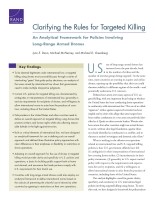| 来源类型 | Research Reports
|
| 规范类型 | 报告
|
| DOI | https://doi.org/10.7249/RR1610
|
| 来源ID | RR-1610-OSF
|
| Clarifying the Rules for Targeted Killing: An Analytical Framework for Policies Involving Long-Range Armed Drones |
| Lynn E. Davis; Michael J. McNerney; Michael D. Greenberg
|
| 发表日期 | 2016
|
| 出版年 | 2016
|
| 页码 | 24
|
| 语种 | 英语
|
| 结论 |
What Is the Current Landscape on Drone Use in Targeted Killings?- To be deemed legitimate under international law, a targeted killing using drones must successfully pass through a series of interlocking "gates" that guide policy decisions; our analysis of the issues raised by international law shows that governments need to make multiple interpretive judgments.
- Current U.S. policies on using drones for targeted killing are characterized by ambiguities in interpretations of international law, generality in end-use requirements for recipients of long-range armed drones, and willingness to allow international norms to arise from the practices of countries, including those of the United States.
- The Obama administration's reluctance to pursue international norms has created an environment in which other countries could employ long-range armed drones in ways that undermine U.S. interests (that is, in secretive fashion, without clear legal foundations, against domestic dissidents, in ways that exacerbate regional tensions).
What Steps Should Be Taken? - Policymakers in the United States and other countries need to define an overall approach for targeted killing using long-range armed drones that protects civilians and human rights while also allowing reasonable latitude in the fight against terrorism.
- Built on critical elements of international law, we have designed an analytical framework for use in defining such an overall approach and defined three illustrative policy approaches with clear differences in their emphasis on flexibility or restrictions in long-range armed drone operations.
- Adopting an overall approach for the use of drones in targeted killing would provide clarity and specificity in U.S. policies and operations, a basis for building public support both at home and abroad, assurance that trade partners comply with U.S. requirements for their lawful use, and a foundation for a U.S. leadership role in the design of international norms.
|
| 主题 | Counterterrorism
; International Humanitarian Law
; United States
; Unmanned Aerial Vehicles
|
| URL | https://www.rand.org/pubs/research_reports/RR1610.html
|
| 来源智库 | RAND Corporation (United States)
|
| 引用统计 |
|
| 资源类型 | 智库出版物
|
| 条目标识符 | http://119.78.100.153/handle/2XGU8XDN/108369
|
推荐引用方式
GB/T 7714 |
Lynn E. Davis,Michael J. McNerney,Michael D. Greenberg. Clarifying the Rules for Targeted Killing: An Analytical Framework for Policies Involving Long-Range Armed Drones. 2016.
|
|
文件名:
|
x1495316353611.jpg
|
|
格式:
|
JPEG
|

|
文件名:
|
RAND_RR1610.pdf
|
|
格式:
|
Adobe PDF
|
除非特别说明,本系统中所有内容都受版权保护,并保留所有权利。